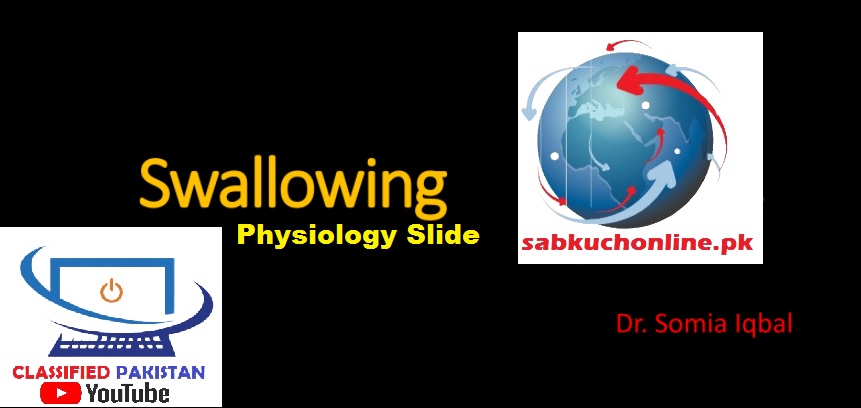Swallowing
- Deglutition or swallowing is the process by which food moves from mouth into stomach.
- Three stages/phases:
- Oral stage—Voluntary
- Pharyngeal stage—Involuntary
- Esophageal stage—Involuntary
Deglutition—Oral stage
- When bolus is ready for swallowing (placed over postero-dorsal surface of the tongue-preparatory position).
- Tongue move upward & backwards against the palate.

- Tongue move upward & backwards against the palate.
- Food is voluntarily squeezed/rolled posteriorly into the pharynx.
Deglutition– Pharyngeal stage-in les than 6 seconds

- The soft palate move upward close the posterior nares —prevents the food from entering the nasal cavities.
- The palatopharyngeal folds on each side of the pharynx are pulled medially form slit through which food passes into posterior pharynx.
- The vocal cords of the larynx are approximated and the larynx is pulled upward and anteriorly cause the epiglottis to swing backward over the opening of the larynx (All these effects prevent food from going into the nose and trachea).
- Upper esophageal sphincter relaxes
- Peristalsis wave of contraction initiated in the pharynx moves food from pharynx through the upper esophageal sphincter.

Effect on respiration
- The entire pharyngeal stage occur in less than 6 seconds, thereby interrupting the normal respiratory cycle for fraction of seconds.
- The swallowing center inhibit respiratory center of medulla during this point—-halting the respiration at this point of cycle.
- But it is for such a short period of time that it is hardly noticeable.
Deglutition– Esophageal stage
- Involuntary stage involves conduction of food from pharynx to stomach By two types of Peristaltic Movements:
1: Primary Peristalsis:-
- It is the continuation of pharyngeal peristaltic wave that spreads into esophagus during pharyngeal stage(this wave passes all the way from pharynx to stomach in about 8-10 seconds).
2: Secondary Peristalsis:
- Appear if primary peristalsis fail to move the food that enters esophagus into the stomach.
- It results from the distention of esophagus by retained food.
- Initiated partly by Myenteric plexus & partly by reflex initiate in the pharynx
→send vagal afferents to the medulla and back through vagal and glossopharyngeal nerve.
- When a peristaltic swallowing wave passes down the esophagus
- Receptive Relaxation of lower esophageal sphincter occur,
- Allowing entering of food into the stomach.
- Even when this peristalic wave reaches down to stomach it causes receptive relaxation of stomach through myenteric inhibitory neurons—-thus prepare stomach ahead of time to receive food.

- • Musculature of upper 1/3 of esophagus (striated muscles) are innervated by vagus (10th cranial) & glossopharyngeal nerves (9th cranial),
Musculature of the lower two thirds of the esophagus is smooth muscle (controlled by the vagus through connections with the esophageal myenteric nervous system).
LOWER ESOPHAGEAL SPHINCTER:
At lower end of esophagus,3cm above its junction with stomach, esophageal circuler muscles function as LES.
Nerve supply:
- Mainly vagus nerve +++
- Myenteric plexus++
- Splancnic nerve+/-
- At rest, LES is in tonically contracted state.
- During swallowing, When Peristaltic wave reach to down in esophagus → Receptive relaxation of LES occur (vagus mediated inhibition by nitric oxide or by VIP relaxation) → Food propulsion from esophagus to stomach.
LES again contracted →prevent reflex of stomach content into the esophagus. GERD (gastroesophageal reflux)
Paralysis of swallowing mechanism
- Paralysis of CN 5,9,10
- Damage to swallowing center—poliomyelitis or encephalitis
- Paralysis of muscles of swallowing—muscle dystrophy, failure of neuromuscular transmission (myasthenia gravis)
- Coma/deep anesthesia
- Achalasia
Achlasia / Megaesophagus
- It is the condition due to high resting pressure at the LES that fails to relax during swallowing.
- As a result, food transmission from the esophagus into the stomach is prevented.
- Physiological basis:
- Absence of inhibitory ganglia in the myenteric plexus containing VIP & NO in the lower third of esophagus
- The musculature of the lower esophagus instead remains contracted and the myenteric plexus has lost the ability to transmit a signal to cause relaxation of the LES.
- Physiological basis:
- Esophagus fails to empty its food in the stomach.
- With passage of time, esophagus become enlarge (mega esophagus)—–store up to 1 liter of food.
- Symptoms:
- Difficulty in swallowing both solids and liquids
- Occasional regurgitation
- Indigestion/heart burn
- Weight loss

Investigation of choice –barium swallow
Management:
- Medical—–anti-spasmodiac drugs/antacids
- Invasive—–balloon inflation
- Surgical— esophagomyotomy
Dysphagia
- Difficulty in swallowing.
- Characteristic manifestation of dysphagia is the sensation of food “sticking” somewhere in its passage to the stomach.
- Causes:-
- Mechanical obstruction of esophagus e.g. tumor, stricture, diverticular hernia etc.
- Decreased movement of esophagus due to neurological disorder
- e.g. parkinsonism
- 3. Muscular disorders e.g. of mouth or esophagus
Click here for Download slideshow
Click below for more Physiology slideshow Lectures
Physiology PowerPoint Slides Archives – sabkuchonline.pk
